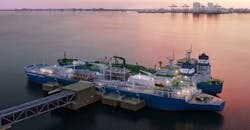Wärtsilä Gas, Hoegh Evi Finish Work on Floating Ammonia-to-Hydrogen Cracker in Norway
Maritime energy infrastructure firm Hoegh Evi and Wärtsilä Gas Solutions have completed development of the world’s first floating ammonia-to-hydrogen cracker facility in Norway.
The focus of the technology is improving the ability of import terminals to produce hydrogen from transport ammonia at an industrial scale. Both ammonia and hydrogen are carbon-free in their molecular chains and are envisioned as potentially decarbonizing fuel resources for some shipping and power generation.
Hoegh Evi and Wärtsilä Gas Solutions, part of the Finnish power equipment giant Wärtsilä Corp., began the project two years ago in line with Norway’s green platform program. The industrial-scale ammonia cracker has a modular design allowing integration into both hybrid Floating Storage and Regasification Units and Floating Hydrogen Terminals.
"This pioneering development of the floating ammonia-to-hydrogen cracker represents a significant leap forward in our quest for sustainable energy solutions,” said Walter Reggente, Vice President of Wärtsilä Gas Solutions, in a statement. “Together with Höegh Evi and our partners, we are not only addressing the challenges of hydrogen storage and transportation but also paving the way for a more resilient and flexible energy infrastructure."
The technology is scalable with a sendout capacity of up to 210,000 tons of hydrogen annually. Ammonia storage ranges from 10,000 cubic meters to 120,000 cubic meters.
Ammonia is an energy-dense chemical composed of nitrogen and hydrogen with the formula NH3, and is known as an efficient energy carrier of hydrogen (H2). It is a component in the manufacture of many fertilizers and refrigerants and, through the thermal cracking process, can produce hydrogen.
According to the EU's REPower strategy, Europe plans to import 10 million tons of renewable hydrogen per year by 2030. As the development of the hydrogen grid progresses, floating infrastructure with ammonia cracking technology is capable of releasing large-scale imports, supplying hard-to-abate industries with a stable, decarbonized and baseload energy source and balance within the energy system.
Hoegh Evi is developing several hydrogen terminal projects in Europe scheduled to start operations before 2030.
The project has secured a grant of about $6.7 million from the Norwegian Government's green platform program, representing approximately 50 percent of the total budget. The ammonia cracker was constructed at Sustainable Energy's Norwegian Catapult Center in Stord, Norway. Additional partners in the project were the Institute for Energy Technology (IFE), University of South-East Norway, Sustainable Energy and BASF SE.
Innovation Norway, a Norwegian trade promotion organization, is partly responsible for the allocation of funds within the Green Platform program.
Baker Hughes is working with shipbuilder Hanwha Ocean on delivering ammonia combustion systems to smaller vessels and offshore energy facilities.
About the Author
EnergyTech Staff
Rod Walton is senior editor for EnergyTech.com. He has spent 17 years covering the energy industry as a newspaper and trade journalist.
Walton formerly was energy writer and business editor at the Tulsa World. Later, he spent six years covering the electricity power sector for Pennwell and Clarion Events. He joined Endeavor and EnergyTech in November 2021.
He can be reached at [email protected].
EnergyTech is focused on the mission critical and large-scale energy users and their sustainability and resiliency goals. These include the commercial and industrial sectors, as well as the military, universities, data centers and microgrids.
Many large-scale energy users such as Fortune 500 companies, and mission-critical users such as military bases, universities, healthcare facilities, public safety and data centers, shifting their energy priorities to reach net-zero carbon goals within the coming decades. These include plans for renewable energy power purchase agreements, but also on-site resiliency projects such as microgrids, combined heat and power, rooftop solar, energy storage, digitalization and building efficiency upgrades.
